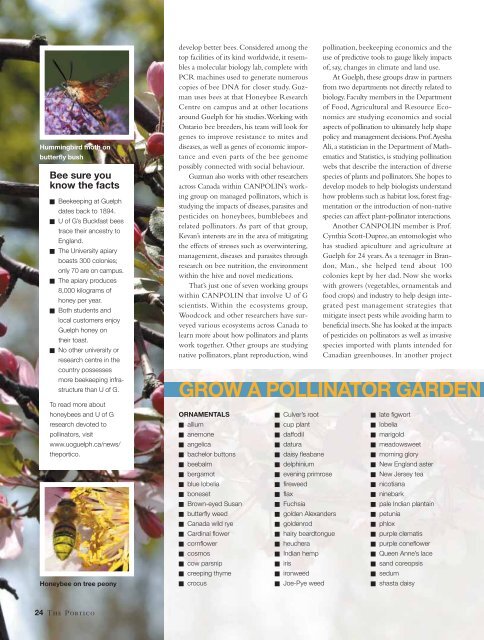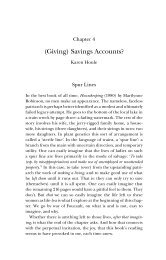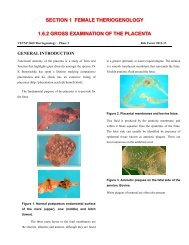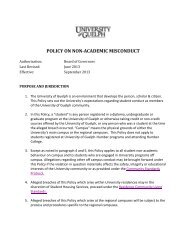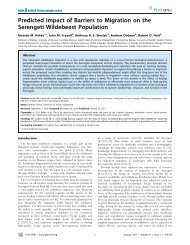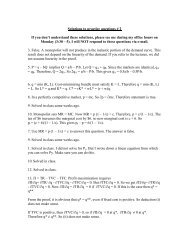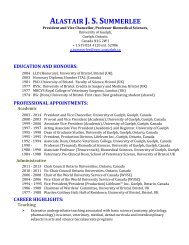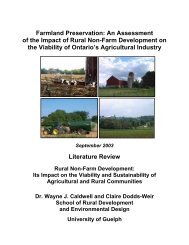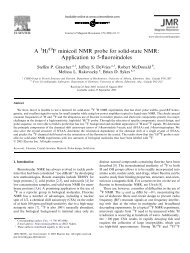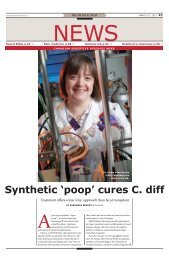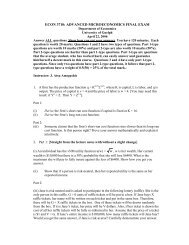Hummingbird moth onbutterfly bushBee sure youknow the facts■ Beekeeping at <strong>Guelph</strong>dates back to 1894.■ U <strong>of</strong> G’s Buckfast beestrace their ancestry toEngland.■ The <strong>University</strong> apiaryboasts 300 colonies;only 70 are on campus.■ The apiary produces8,000 kilograms <strong>of</strong>honey per year.■ Both students andlocal customers enjoy<strong>Guelph</strong> honey ontheir toast.■ No other university orresearch centre in thecountry possessesmore beekeeping infrastructurethan U <strong>of</strong> G.To read more abouthoneybees and U <strong>of</strong> Gresearch devoted topollinators, visitwww.uoguelph.ca/news/theportico.Honeybee on tree peonydevelop better bees. Considered among thetop facilities <strong>of</strong> its kind worldwide, it resemblesa molecular biology lab, complete withPCR machines used to generate numerouscopies <strong>of</strong> bee DNA for closer study. Guzmanuses bees at that Honeybee ResearchCentre on campus and at other locationsaround <strong>Guelph</strong> for his studies. Working withOntario bee breeders, his team will look forgenes to improve resistance to mites anddiseases, as well as genes <strong>of</strong> economic importanceand even parts <strong>of</strong> the bee genomepossibly connected with social behaviour.Guzman also works with other researchersacross Canada within CANPOLIN’s workinggroup on managed pollinators, which isstudying the impacts <strong>of</strong> diseases, parasites andpesticides on honeybees, bumblebees andrelated pollinators. As part <strong>of</strong> that group,Kevan’s interests are in the area <strong>of</strong> mitigatingthe effects <strong>of</strong> stresses such as overwintering,management, diseases and parasites throughresearch on bee nutrition, the environmentwithin the hive and novel medications.That’s just one <strong>of</strong> seven working groupswithin CANPOLIN that involve U <strong>of</strong> Gscientists. Within the ecosystems group,Woodcock and other researchers have surveyedvarious ecosystems across Canada tolearn more about how pollinators and plantswork together. Other groups are studyingnative pollinators, plant reproduction, windORNAMENTALS■ allium■ anemone■ angelica■ bachelor buttons■ beebalm■ bergamot■ blue lobelia■ boneset■ Brown-eyed Susan■ butterfly weed■ Canada wild rye■ Cardinal flower■ cornflower■ cosmos■ cow parsnip■ creeping thyme■ crocus■ Culver’s root■ cup plant■ daffodil■ datura■ daisy fleabane■ delphinium■ evening primrose■ fireweed■ flax■ Fuchsia■ golden Alexanders■ goldenrod■ hairy beardtongue■ heuchera■ Indian hemp■ iris■ ironweed■ Joe-Pye weedpollination, beekeeping economics and theuse <strong>of</strong> predictive tools to gauge likely impacts<strong>of</strong>, say, changes in climate and land use.At <strong>Guelph</strong>, these groups draw in partnersfrom two departments not directly related tobiology. Faculty members in the Department<strong>of</strong> Food, Agricultural and Resource Economicsare studying economics and socialaspects <strong>of</strong> pollination to ultimately help shapepolicy and management decisions. Pr<strong>of</strong>. AyeshaAli, a statistician in the Department <strong>of</strong> Mathematicsand Statistics, is studying pollinationwebs that describe the interaction <strong>of</strong> diversespecies <strong>of</strong> plants and pollinators. She hopes todevelop models to help biologists understandhow problems such as habitat loss, forest fragmentationor the introduction <strong>of</strong> non-nativespecies can affect plant-pollinator interactions.Another CANPOLIN member is Pr<strong>of</strong>.Cynthia Scott-Dupree, an entomologist whohas studied apiculture and agriculture at<strong>Guelph</strong> for 24 years. As a teenager in Brandon,Man., she helped tend about 100colonies kept by her dad. Now she workswith growers (vegetables, ornamentals andfood crops) and industry to help design integratedpest management strategies thatmitigate insect pests while avoiding harm tobene ficial insects. She has looked at the impacts<strong>of</strong> pesticides on pollinators as well as invasivespecies imported with plants intended forCanadian greenhouses. In another projectGROW A POLLINATOR GARDEN■ late figwort■ lobelia■ marigold■ meadowsweet■ morning glory■ New England aster■ New Jersey tea■ nicotiana■ ninebark■ pale Indian plantain■ petunia■ phlox■ purple clematis■ purple coneflower■ Queen Anne’s lace■ sand coreopsis■ sedum■ shasta daisy24 The Portico
■ shrubby cinquefoil■ snowdrop■ smooth aster■ sunflower■ swamp milkweed■ trumpet honeysuckle■ trumpetvine■ Virginia creeper■ wild columbine■ wild onion■ wild strawberry■ yellow coneflower■ yellow giant hyssopSHRUBS■ blueberry■ cedar■ climbing hydrangea■ dogwood■ eastern white cedar■ elderberry■ highbush cranberry■ juniper■ northern bayberry■ pussywillow■ red currant■ serviceberry■ shrubby cinquefoil■ sumac■ winterberry■ viburnumTREES■ crab apple■ chokecherry■ fruit treesfunded by an Agriculture and Agri-FoodCanada/NSERC grant, Scott-Dupree lookedat how different ways <strong>of</strong> growing canolaaffected wild bees and how growers mightalter their management practices to boost pollinatornumbers and diversity.“More seeds mean more oil,” she says,underscoring pollinator diversity as a foodsecurity issue. “It’s important to have beesand other pollinators there.”If that’s true for commercial growers, it alsoholds for home gardens and public spaces:even former garbage dumps. What many<strong>Guelph</strong> residents still view as the former Eastviewlandfill site is intended as the futurehome <strong>of</strong> a 45-hectare pollinator park. Thisproject will turn the site into a pollinatordemonstration model, says landscape architectKaren Landman. She is a lead researcher onthe project, working with a number <strong>of</strong> <strong>Guelph</strong>faculty, city <strong>of</strong>ficials and other local groups.They’ll begin the rehabilitation this year byplanting five hectares <strong>of</strong> the site with species<strong>of</strong> flowers that attract bees, butterflies and birds.Organized as Pollination <strong>Guelph</strong>, the groupalso plans to develop pollinator gardens at otherdemonstration sites around the city, includinga garden planned for the <strong>Guelph</strong> Centrefor Urban Organic Farming, a one-hectareparcel in the Arboretum, and residential siteshousing the city’s water pumping stations.Marianna Horn, a graduate student workingwith Kevan, is studying urban bee diversityin <strong>Guelph</strong>, Cambridge, Kitchener andWaterloo. She says there are <strong>of</strong>ten more beesand more diversity <strong>of</strong> bees in sites zonedindustrial than in many green areas. Recentlydeveloped subdivisions, she adds, are thepoorest places for pollinators in our cityscapes.All the more reason, says Landman, toshowcase plant materials that attract pollinatorsand test ideas for low-irrigation, pesticide-freegardening that looks good.“We’re trying to create functional butesthetic landscapes,” she says.Victoria MacPhail, M.Sc. ’07, is anothermember <strong>of</strong> Pollination <strong>Guelph</strong> who stressesthe importance <strong>of</strong> educating home gardeners.She served as CANPOLIN’s networkmanager during its launch in 2008 and isnow a natural heritage technician withCredit Valley Conservation. She also wrotea guidebook on pollinator-friendly nativeplants for the Toronto area, a project <strong>of</strong> theDavid Suzuki Foundation.Many <strong>of</strong> the plants she recommendedfor city dwellers are evident in the <strong>University</strong>’sGosling Wildlife Gardens and willbe planted in the Eastview demonstrationsite. Their common names are also printedbelow this story to illustrate the idea thatwe as individuals can also contribute toCANPOLIN’s overarching mandate: protectingpollinators. ■IN YOUR OWN BACKYARD■ hop tree■ poplar■ willowVEGETABLES ANDHERBS■ catnip■ coriander■ dwarf egg plant■ lavender■ mint■ parsley■ peppers■ pumpkin■ rosemary■ sage■ salvia■ thymeU <strong>of</strong> G bee yardGrow pollenin your gardenPaul Kelly manages the U <strong>of</strong> G bee yard, butChris Earley, B.Sc. ’92, likes to claim the honey.An interpretive biologist and education coordinatorat the Arboretum, Earley teases: “The70 honeybee colonies located on campus aremaking Arboretum honey.”It’s a safe bet that the insects are takingadvantage <strong>of</strong> the Arboretum’s flowering plants,shrubs and trees. In fact, the Arboretum takescare to ensure a plentiful menu <strong>of</strong> plants withinthe Gosling Wildlife Gardens to attract beesand other pollinators.“A lot <strong>of</strong> people think pollinators and justthink <strong>of</strong> bees,” says Earley. Think again. Otherpollinators include numerous species <strong>of</strong> flies,butterflies, mosquitoes, moths, beetles, batsand birds — not to mention one abiotic factor:wind. “You don’t even think <strong>of</strong> them as beingpollinators.”Visit the Arboretum at the right time, hesays, and you might spot a ruby-throated hummingbirddipping into a trumpet creeper’s scarletbloom. Or you might see a hummingbirdmoth, so-named for the insect’s resemblanceto the bird, right down to its retractile proboscisand its daytime foraging. Or any one <strong>of</strong> severalspecies <strong>of</strong> tachinid bristle flies, whose hairybodies collect pollen much like a bee’s does.Goldenrod nectar is a favoured food for beetles,and a larval bed in the garden containsplants that attract butterflies whose caterpillarstages require special feeding, including thepearly everlasting plant for the American ladybutterfly and milkweed for the monarch.Each photo in this feature depicts both apollinator and a favoured bloom growing in theU <strong>of</strong> G Arboretum. Our thanks to the photographers:Chris Earley, Jon Bierley, LyndsayFraser and Paul Kelly.<strong>Summer</strong> <strong>2010</strong> 25


